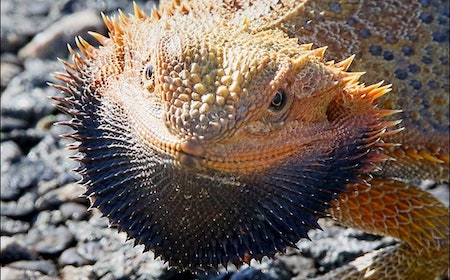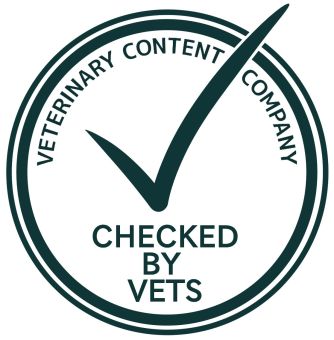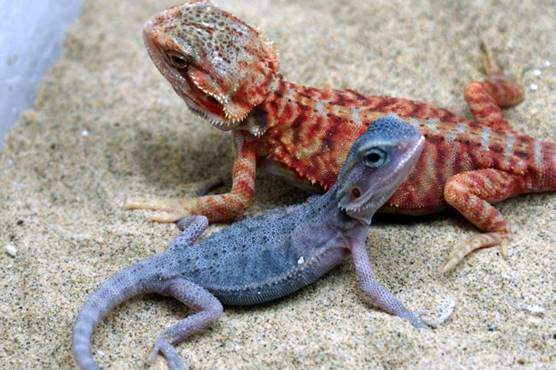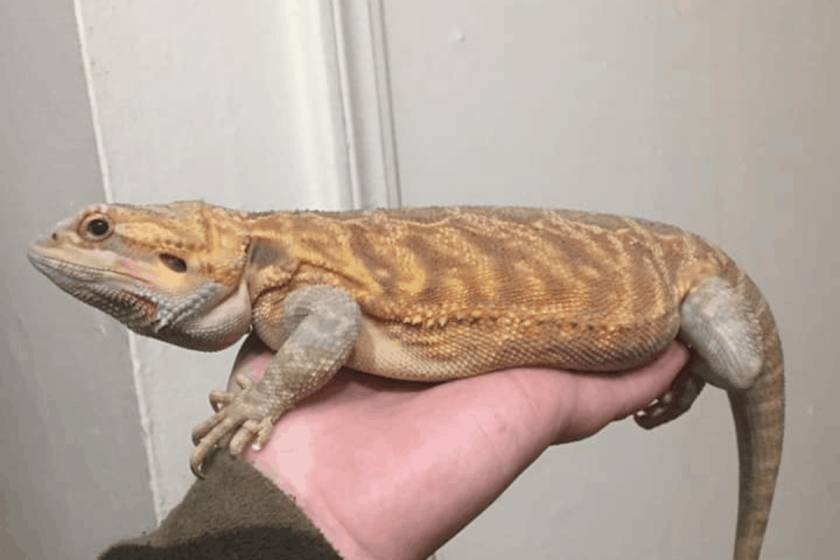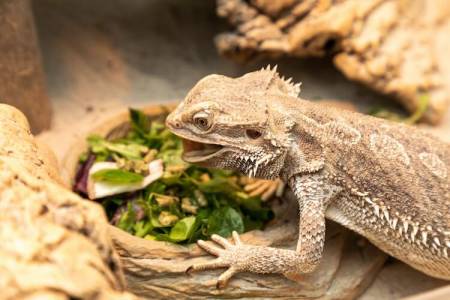Connect with a verified veterinarian in minutes. Licensed vets are available 24/7 to answer your questions. No need to worry about your furry family member.
What does it mean when a bearded dragon has a black beard? This can be a frightening development, especially for first-time bearded dragon pet parents. Is this something to be concerned about?
In this article, we’ll take a look at some of the most common causes of a black color beard in bearded dragons. Let’s get started!
1). Getting Used to a New Tank
View this post on Instagram
Bearded dragons can easily become overwhelmed when their environment goes through a major change. Think of how it must feel to them! They’ve been in one place for a while, which may be a pet shop or a breeder’s home. Then they’re transported to a new environment and new enclosure! What’s happened? Would bearded dragon owners feel comfortable in that situation?
Bearded dragons need time to get used to their new surroundings. This means they need to become accustomed to your new home and their terrarium. There are many new things to see, hear, and more. Even the air may smell different in their new place.
So, when you bring a new bearded dragon home, you may notice their beard has turned black. This could be due to feeling a bit anxious or stressed by their whole experience in making big changes.
The black beard is a sign they’re not comfortable and may even be afraid. So, give them space. And don’t handle them until they give the sign they’re feeling better. That means when the dragon’s beard goes from black to its normal color.
2). Fear
View this post on Instagram
A bearded dragon’s beard can also turn black because of fear. You may also notice your dragon “puffing up,” which is a way wild dragons try to deter threats. Even bearded dragons raised in captivity will still use this method when they perceive a threat. They may believe they’re in danger when that’s really not the case.
Bearded dragons may be afraid of being in a new place, seeing other pets, and more. For this reason, it’s best to keep your dragon’s tank in a quiet place, away from windows. And make sure to keep other pets away from them.

Review symptoms, medications & behavior to keep your pets healthy with a Vet Online in just minutes.
Ask a Vet Live Now3). Your Dragon May Not Be Comfortable with You
It’s entirely possible your new dragon isn’t yet comfortable with you. If you’re new to the dragon, they don’t know if you’re going to hurt them or not. So, they may develop a black beard to show their unease.
For this reason, it’s best to avoid handling a new bearded dragon too much right away. It’s best to give them time to become used to their new tank, your home, etc.
When it’s time to handle them, do so gently and increase the amount of time as the dragon becomes used to you. Paying attention to your dragon’s beard and body language is part of being a good and responsible pet parent.
View this post on Instagram
4). Anger
Another reason a dragon’s beard may turn black is because they’re angry. This is a huge indicator your beardie wants to be left alone. Keep in mind that it may not be you that’s the problem. It could even be something nearby their tank.
Beardies may become angry for many reasons. These can include loud noise in the room, people tapping on the sides of their tank, and more. It may take a little bit to figure out what’s making your dragon angry, but it’s well worth the effort.
You don’t want to have an angry dragon, do you?
5). Your Dragon Could be Ill
When you’re a first-time dragon pet parent, it’s hard to understand all the signs they give that something’s wrong. In this case, it’s possible your beardie could be sick if his beard turns black.
There are many common reasons a bearded dragon may use this method to indicate they’re sick. One comes from their wild cousins. In the wild, it’s thought bearded dragons’ beards may turn black to make them look more intimidating. This may work to hide that they’re actually sick. It seems to work well for our beardies’ wild cousins.
Bearded dragons’ beards may also turn black when they’re uncomfortable, which can be a sign of illness. When you don’t feel well, you’re not very comfortable. It’s the same for your dragon. This could be a sign that something’s not right somehow.
However, if your beardie is otherwise acting normally and eating, then the black beard maybe for another reason. If you’re concerned, it’s best to call the vet for advice.
View this post on Instagram
6). Your Beardie Could be Cold
When bearded dragons turn their beards black, it can be an indication they’re too cold. They do this to help warm themselves up. This is because black can absorb more heat than lighter colors.
So, if your bearded dragon’s beard is black, it could be that he’s cold. This is a great time to check his body temperature or the temperaturein his tank. If the temperature’s too low, then you’ll need to increase the heat. This can be done with UVB bulbs or ceramic heaters.
7). Looking for a Mate
Another reason bearded dragons turn their beards black is that they’re seeking a mate! This is done by the males. Male beardies have darker beards than female beardies, and so use this dark beard as a means to indicate how masculine they are. You may also notice your beardie’ head bobbing or moving his head at the same time. This is another way to get more attention.
If you have only one beardie and no other, then you won’t notice this bearded dragon behavior.
View this post on Instagram
8). Territorial
Being territorial is another reason a beardie’s beard may turn black. But you may notice this only if you have more than one bearded dragon in a tank.
Males use this method to indicate their territory, so if you have two males in the same tank, it may be necessary to move one of them to a new enclosure.
Females housed together will often experience bullying or fighting behavior, if there isn’t enough space or they perceive not enough resources, even if they are related females.
View this post on Instagram
Bearded Dragon Care Guide
Bearded Dragon and Brumation
Bearded dragons are cold-blooded reptiles, which means they have a relatively slow metabolism. The slower the metabolism, the slower the process of body temperature.
. Lowering temperatures reduced light levels and fewer resources (fewer food/prey items around in colder months) are all cues that may cause the bearded dragon to go into brumation. They are resting during the coldest part of their season and will become more active again when temperatures rise. This process is important for bearded dragons to be able to survive in their native environment.
Even though they can go into brumation, it is not always desirable for bearded dragons, and young bearded dragons, who have insufficient fat stores, don’t generally enter brumation. In their native environment, brumation allows them to conserve energy and store fat. But when they are brought into a new home and begin to feel stressed, this behavior may cause them to become loose weight as well asdevelop other health problems like constipation, intestinal blockages or skin diseases such as tail rot. . These can be serious issues for bearded dragons if not treated in time!
Bearded dragons do not have an internal clock, so they will stay in brumation for months at a time. While in brumation, bearded dragons will appear to be sleeping more often, similar to hibernation in other species, but they usually move around a little each day, eat far less, bask less frequently and burrow in substrate more. They will spend more time in darker, cooler hiding spots. Bearded dragons that are being kept as pets in captivity do not need to be brumating in order to survive.
Bearded dragons in brumation will eat or drink significantly less..It is important to keep a full bowl of water available even if they arent showing a lot of interest in it as they will still need water in brumation. . If you have a bearded dragon that is brumating, it is important to provide a warm, darker place for them to go. This could be a cave or an enclosure that is not too large.
Warm up the bearded dragon by placing it in a tank that is filled with lukewarm water for a few minutes. Then, remove the bearded dragon from the tank and allow it to brumate. If you do not want to place your bearded dragon in a brumation tank, it can be placed in a regular reptile vivarium.
Taking Care of Baby Beardies During Brumation
Baby beardies shouldn’t go into brumation at all, usually this process starts at around 10months of age. Brumating early could affect their growth as the process slows down the metabolism process and effects the developmental process.
If you notice your young beardie displaying behaviors consistent with early brumation or your older beardies showing other symptoms such as a black beard, weight loss, tail rot or a generalized change in color, seek veterinary advise as this may be a sign that your beardie is unwell.
Basking in the Sun
During the summer, bearded dragons are at their most active. When temperatures are warm enough, they will spend most of their time basking in the sun. They will move around and even climb onto rocks to get out of the water to get more heat. When it gets too hot for them to be in direct sunlight, they will go into hiding in shaded areas. This is why it is important to have a bearded dragon basking area that is well-ventilated and has plenty of shady spots for them to hide.
A bearded dragon that does not get enough sunlight may become lethargic and stop eating. This is known as Photo Invertebrate Syndrome (PIS). Bearded dragons need about six hours of sunlight a day to be healthy, so if they do not have access to sunlight for this amount of time, they can develop PIS. This condition may also cause skin problems like sunburn or dermatitis.
The Mating Season
When the breeding season comes around, bearded dragons will begin to become more aggressive. They will also become more territorial. Males will also begin to change color, and they may become almost completely black.
Bearded dragons can be bred in captivity if they are in good health and have enough room to live comfortably together. They can be bred at any age as long as they are eating well and are healthy overall. Females will become receptive to mating when they are between 2 and 3 years old.
Bearded dragons have separate sexes, and males can be identified by their large size and long tails. Females are smaller than males, with shorter tails. When a female is ready to mate, she will go into a crouching position and start releasing pheromones. Males will then try to get close enough to smell her and see if she is receptive to mating. If she is, he will start to climb on her back and mate.
Feeding Bearded Dragons
While bearded dragons are not technically omnivores, they will eat almost anything. They have been known to eat all sorts of items including seeds, fruit, and insects. Their diet can vary depending on their habitat and their mood.
In the wild, bearded dragons are omnivores, which means they will eat both plants and animals. In captivity, they can be fed a wide variety of foods including:
- Live foods (such as crickets, wax worms, mealworms, and superworms)
- Granular or powdered vitamins
- Vegetables (such as greens, lettuce, spinach, and zucchini)
- Fruits (such as apples, bananas, and oranges)
A balanced diet, life stage appropriate should be provided including calcium and vitamin D3, mineral supplementation. Baby beardies (< 5 months) should be fed 60-80% insects and 20-40% plant matter. Juveniles (5-18 months of age) should be fed 50% insect and 50% plant matter. Adult beardies should be provided with 25-30% insect and 70-75% plant matter. Food should be dusted with calcium/ mineral supplementation at least once weekly. Insects can be “gut loaded” or fed protein-rich food 24hrs before feeding them to your beardie to make sure your beardie gets the most nutrition possible out of them.
You can mix fruits with vegetables, or mix greens with fruits or vegetables. Just make sure that the items you mix are different types of food! If you do not mix food types often enough, your bearded dragon may become underweight because he will not be getting enough nutrients from his diet.
Most beardies, especially adults will do better fed daily. Baby beardies can be fed up to 5 times per day, juveniles 3x per day, and adults typically 2x per day. Typically a good regime to consider is greens are fed in the mornings and insects in the afternoon.
Metabolic Bone Disease
Bearded dragons can be prone to metabolic bone disease, or MBD. Metabolic bone disease is a disease that is caused by a lack of calcium and usually lack of access to UV light (vit D) resulting in weak, improperly formed bones. ,
Fractures are a common complication of weakened bone structure due to the lack of calcium, which can lead to the loss of fingers/toes or other extremities. It can be a very painful condition. Calcium supplementation, vitamin D supplementation, and UV lighting is obviously therefore very important to the health of your beardie.
Bearded dragons do not have a high metabolic rate. A large amount of energy is consumed by maintaining body temperature at a constant level. The rest of their energy is spent on digestion and reproduction. The slow metabolism allows them to store fat and food reserves in their bodies to survive during brumation.
A good diet and activity level are essential for keeping your bearded dragon healthy. If you have any concerns about your bearded dragon, be sure to consult a veterinarian.
A high quality, balanced diet is essential for the proper development of a healthy bearded dragon. Bearded dragons need calcium to build their bones and teeth. They also need protein to grow, as well as fat for energy. In addition, bearded dragons are omnivores, which means they eat both plant and animal foods. A balanced diet can help provide your bearded dragon with all the nutrients it needs to be healthy and strong.
Many owners feed their bearded dragons mealworms, wax worms or other insects as part of their diet. These insects are good sources of protein and calcium, but it is important that these are fed as part of a balanced diet to provide the right nutrients, especially in adult beardies where too many insects and not enough greens can cause obesity and a plethora of other health problems. In addition, some bugs may contain insecticides or pesticides that could harm your bearded dragon if fed in excess amounts.
Connect with a verified veterinarian in minutes. Licensed vets are available 24/7 to answer your questions. No need to worry about your furry family member.
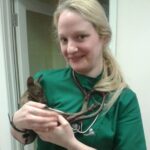
Lily Richards BSc (Hons) BVSc MRCVS
This article has been reviewed and approved by an independent Veterinarian: Lily qualified from Liverpool University in 2011 and spent 5 years as a veterinarian working in mixed animal practice. As Lily’s passion for exotics and exploring more complicated small animal medical cases developed, she stepped into small animal-only practice. By 2018 Lily was leading a busy branch of a large hospital practice with a fantastic team, enjoying working on both surgical and medical cases. Since falling poorly in 2021 Lily has found a new passion in medical writing. Sharing medical knowledge and writing for the public is a particular passion.
Review symptoms, medications & behavior to keep your pets healthy with a Vet Online in just minutes.
Ask a Vet Live Now
